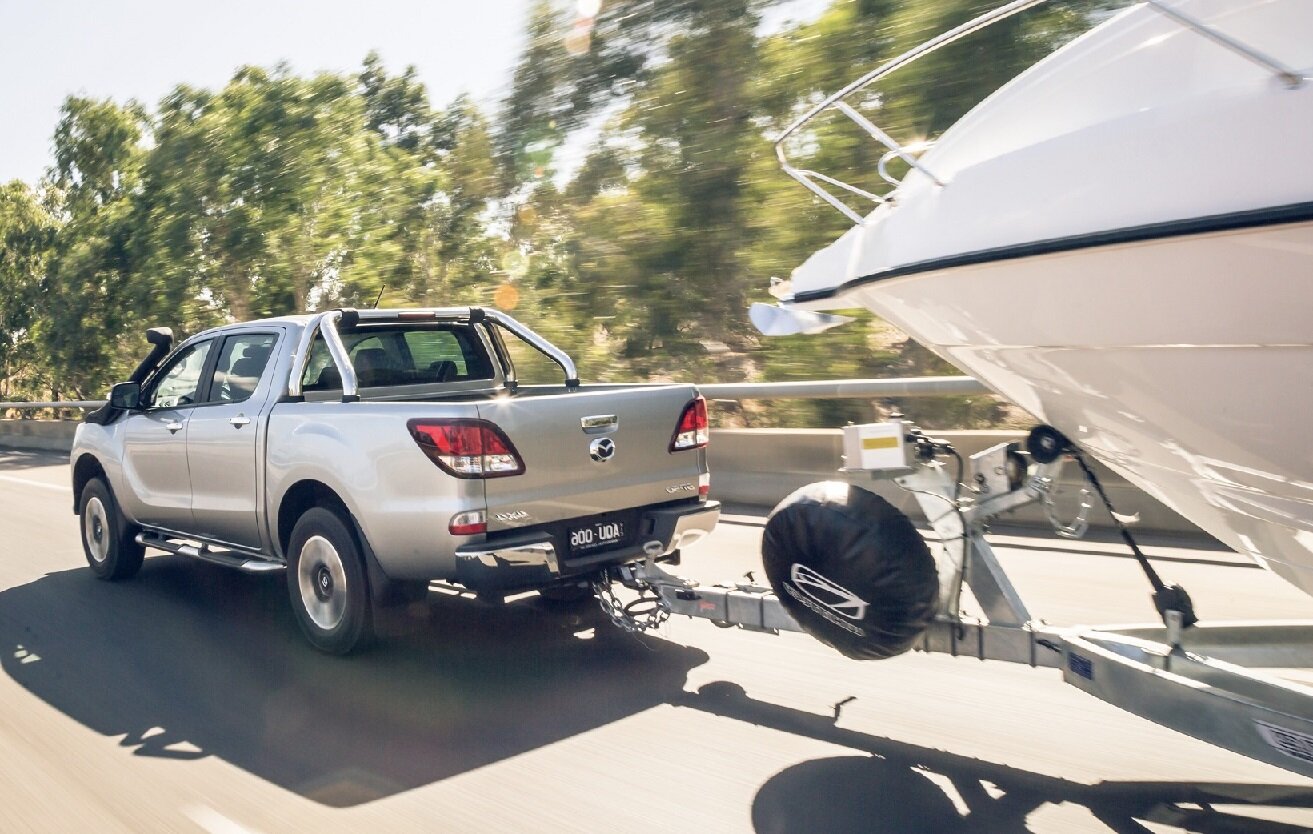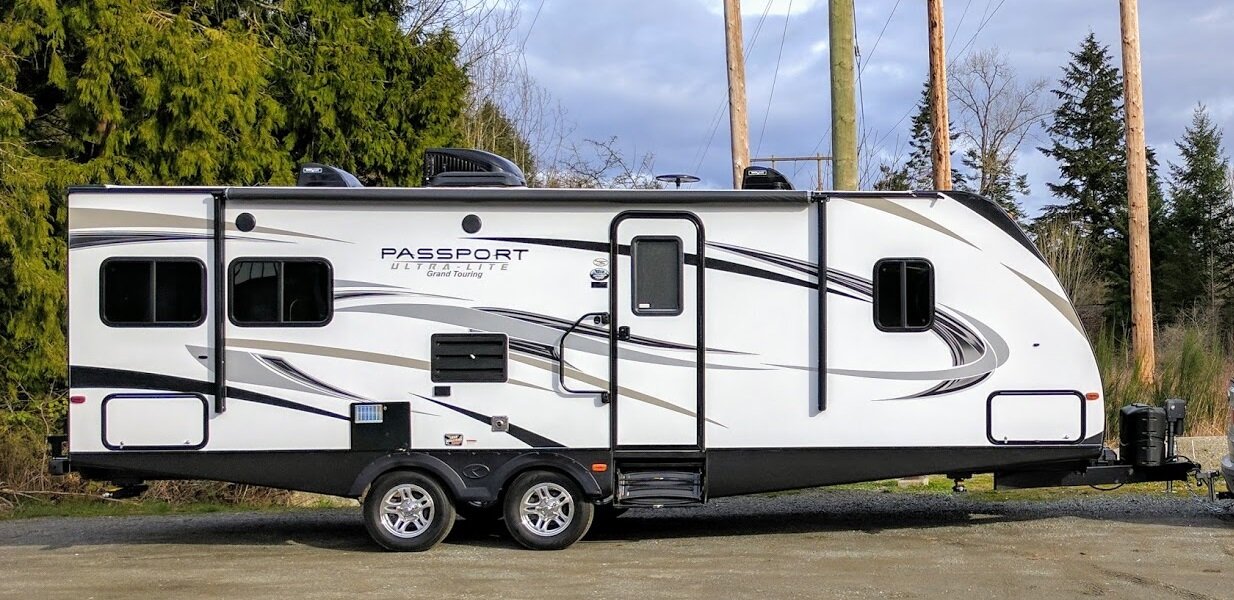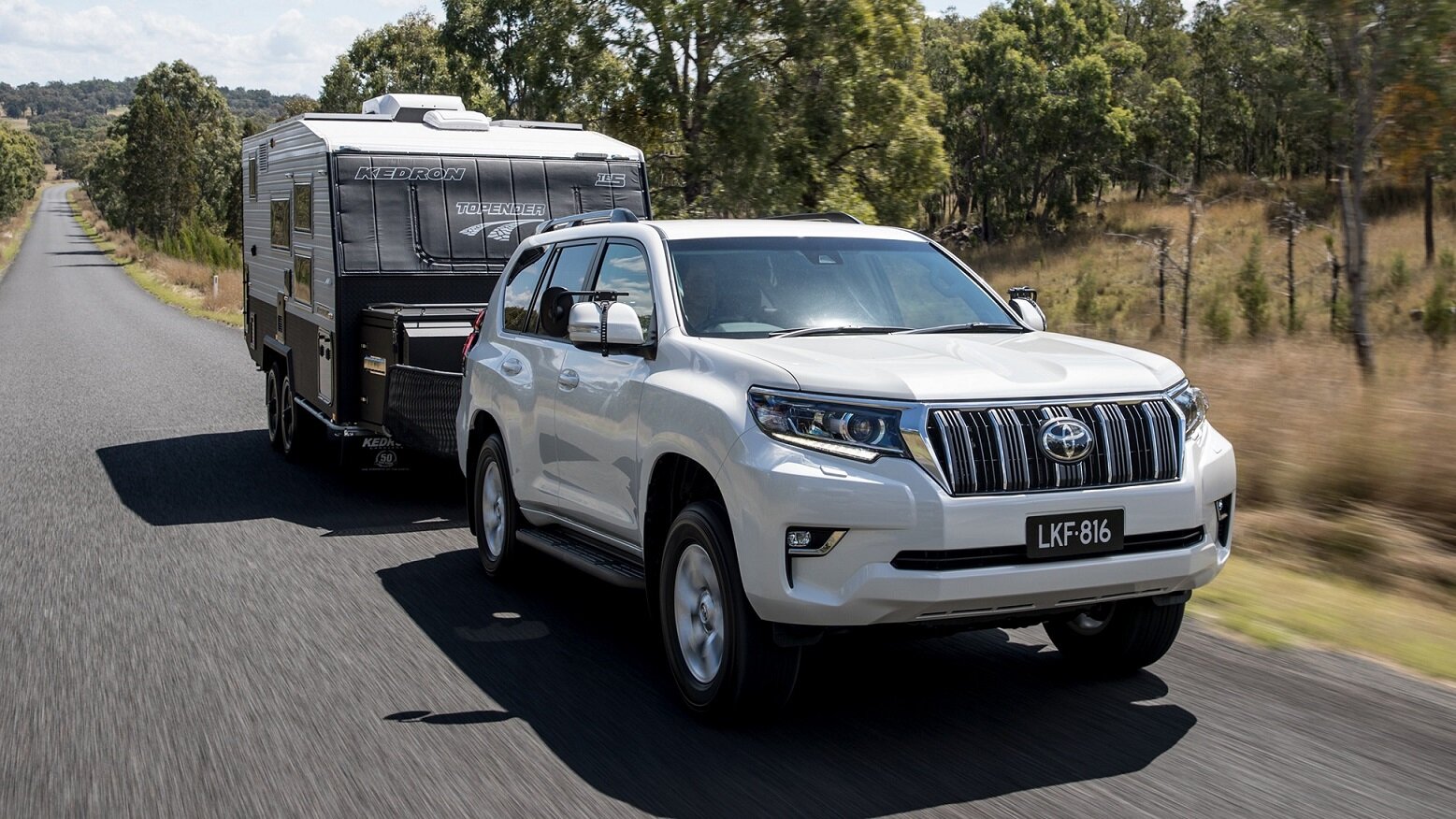Complete heavy towing guide: GVM, GCM, payload, towball limits explained
This is the ultimate guide to heavy towing using a 4X4 wagon like a Toyota LandCruiser or a ute like Ford Ranger - everything you need to know. Let’s get this right…
Raging with machines
The insane automotive arms race for outright towing capacity king has gotta stop.
Attaching a caravan, trailer, horse float - whatever - it’s a safety and risk management issue and this enormous towing-assignment obsession is out of control and it concerns me.
It’s delightfully liberating to blame someone else for your problems, but I think consumers are mainly responsible for pushing demand out to carmakers for wanting to put vast caravans, RVs, camper trailers on the back of their vehicles and head into the bush. And manufacturers of those trailers, and camakers, are largely complying with that demand.
If camakers and recreational vehicle manufacturers stopped meeting that demand, the aftermarket industry, I’m sure, would step in to provide solutions to consumer problems. In many cases, there are businesses already stepping in to do that, with things like GVM upgrades.
If you wanna tow something very, very heavy - the industry isn’t gunna step in and emphatically warn you, Mr & Mrs Consumer, ‘that’s a bad idea’. Which is where I step in…
If you want to understand towing at a deep, meaningful level - like a professional - and you don’t want to be a complete berk about it, you need to understand the basic terms, and how to run the numbers on your rig. (It’s also helpful if everyone uses the same, correct terminology).
When towing, you need to know your shit.
Here are the terms and what they mean:
Tare weight: Empty vehicle, with 10L of fuel
Kerb weight: Empty vehicle, full tank of fuel
GVM (Gross Vehicle Mass): Maximum permissible weight of the vehicle, fully loaded (kerb weight + additional load).
ATM (Aggregate Trailer Mass): Same as GVM but for your full loaded box trailer/caravan/float/boat trailer/camper, maximum permissible weight.
Towball download: Important: amount of vertical load the static trailer imposes on the towball - we’ll get to that - this must be deducted from the vehicle’s payload when doing your calculations.
GCM (Gross Combination Mass): The maximum permissible weight of a tow vehicle including trailer - absolute ATM and GVM weight limit.
Payload capacity: The maximum a vehicle can carry on-board, including a full tank of fuel, passengers, luggage, accessories and towball download.
In this report I also discuss the towing 'arms race' in which people think it's okay to tow a 3500kg trailer with a vehicle that weights 2500kg-ish, and this is often a very bad idea, in my view.
I'll talk you through the payload limitations in the common vehicles and also discuss how you can actually measure your critical weights using a public weighbridge, to ensure you're not driving overloaded - which has important safety, legal and insurance implications.
Also discussed: GVM upgrades and warranty, and the effect of adding accessories on your payload capacity.
.
Tipping the scale
Next time you see the stereotypical Taj Mahal caravan and 4x4 wagon entourage barrelling down the highway, heading into the sunset, take a second to observe.
How much does that van weigh? How much payload have the Grey Nomads or cashed-up bogans shoved in the back, including people, luggage, bullbar and roof rack, jerry cans, banjo etc. Perhaps this is you, rolling the dice with safety with your kids in the back and others beside you at 110km/h.
Just because you’ve bought the top-spec Ranger Wildtrak or LandCruiser Sahara, does not mean you can hitch up to some small moon and it’s all good. The numbers and physics matter here.
Wagons are typically GVM limited. Take the LandCruiser 200 Series, with a 3350kg GVM. Minus its 2740kg kerb weight, leaves you with 610kg of payload, with a 350kg towball download limit (based on that heroic 3.5-tonne braked towing capacity). You’re left with just 260kg of payload. Divided by four people (mum, dad, two kids, for example), that’s 65kg each person can weigh.
You’re going to be dangerously overloaded, I’d suggest.
Similar goes for the Ford Ranger Wildtrak; it might be the trophy truck of your dreams, but it’s not the last word in heavy towing. Here’s why.
A 3.2 automatic Ranger Wildtrak has a 6000kg GCM. Minus the 3500kg ATM (because everybody who owns a Ranger has to be a hero), and you need to deduct the 2278 kerb weight. You’re left with 222kg of permitted payload. Divide that between two adults and two kids: 55.5kg. Between mum, dad and one kid: 74kg each. Just single lads [Tradie 1] and [Tradie 2], that’s 111kg each can weigh.
Whatever you add to your vehicle in terms of payload and accessories, all pushes toward the GVM limit. Here it is in real terms of what you might realistically pack, fit, and buckle up:
People: 3 x 80kg p/p = 240kg
Towbar: 30kg
Bullbar: 40/80/110kg
Fuel: 20L (roughly 20kg per jerry can) + Water: 20kg
Tools: Sockets & spanners, hammer, spade, light-duty air compressor: 20kg
Luggage: 20kg
Additional spare tyre: 20kg
Miscellaneous: (first aid kit, UHF radio, wallet, phone…) 20kg
= 500kg
This is fairly conservative packing. Half a tonne. It’s very easy to exceed your payload limit.
Breaking it down
Let’s do a basic payload comparison using a 150kg towball download benchmark.
Pro tip: Towball download is part of your payload. You must factor it into your vehicle’s GVM and is commonly the reason people get caught overloaded at the roadside by highway patrol and are forced to leave something behind. Anywho…
Keep in mind our vehicle packing exercise above, where 500kg was racked up pretty easily.
LandCruiser 200 Sahara has a 610kg payload, minus the 150kg towball dowload, leaves 460kg of remaining payload.
A Hyundai Santa Fe - which I completely acknowledge is not designed as a heavy towing platform like LandCruiser - in Highlander top-spec has a 635kg payload. Minus 150kg towball download, we’re left with 485kg.
And here’s a list of surprisingly strong payload haulers on the market, just to prove I’m not taking a shot at the LC200 or Ranger Wildtrak.
Ranger XLT: 322kg (average)
Mazda BT-50 Hi-Rider XTR (Ranger platform): 495kg (very good)
Triton GLS Premium: 743kg (excellent)
Hilux Rugged X: 198kg (poor)
Volkswagen Amarok Core 4Motion: 409kg (good)
Hyundai Santa Fe Highlander: 485kg (very good)
Utes
Typically, utes and especially 4x4 utes (because they’re the most popular and passenger/payload oriented), are limited by the Gross Combination Mass because without the trailer, they’re still designed to carry a lot of load.
A Ranger Wildtrak has a 6000kg GCM with the 3.2 diesel engine with auto transmission. It has a 3.5 tonne braked towing limit. If you take away the ATM Taj Mahal trailer weight, you’re left with 222kg. You have to lose something if you’re only packing 222kg of payload, including people.
Also, think about that GCM. Six tonnes. Six tonnes of metal, glass and fluid thundering down the road on school holidays, kids and dog in the back, a giant 3.5-tonne pendulum bolted to the back of a 2.5 tonne ute. The margin for error before a spectacular crash is a terrifying one, not just for those involved, but also for first responders, the eye witnesses and good Samaritans who bring their holiday to a pause in order to pull you and your kids out of the wreckage and dial triple zero.
Now, tell me again why you need to pull 3.5 tonnes into the horizon with your ute. You’re not getting away from it all if you’re taking it all with you.
Launch control
Think about the trailer load and how it is imposed on the vehicle.
The towball pushes up on the trailer, just like the ground. It’s physics.
These are the forces at play. The mass centroid of the trailer is the circle forward of the front trailer axle and that’s where the full weight of your trailer pushes down, 90 per cent opposed by the road and 10 per cent opposed by the towball on the back of your vehicle.
In Australia, 10 per cent is the common towball download limit, which increases dynamic stability as you roll down the road.
It’s particularly bad if the trailer starts lifting the back wheels of your vehicle off the road, or raising the body to the point it unloads the rear suspension and puts your entourage in a very precarious situation.
This is all Newton’s third law of motion at play. The ground pushes against the trailer so it doesn’t drag its arse along the ground and the towball pushes against the A-frame which stops the arse of the car hitting the road.
The worst part of all of this, is the towball download is part of the vehicle’s GVM in terms of what you can actually carry in or on the vehicle.
The physics also makes it crucial to load your vehicle, trailer and caravan correctly, with this key information front-of-mind. Don’t simply throw everything in and hope for the best - that’s a bad idea. You need to plan what goes where and preference heavier items as close to the central mass of the trailer, and over the rear axle of the vehicle so the suspension takes more of the load, rather than treating said suspension as a fulcrum trying to lift the front end and thus creating instability at the bow of your ship.
Disproportionately loading either vehicle not only defies the dynamic stability while you’re driving along, it means in an emergency driving situation or an overtaking manoeuvre, you’re far closer to the point of it all coming unglued. Hard braking means the entourage becomes unstable, you have reduced steering input (it’s hard to turn if your wheels aren’t under load on the road), and the trailer starts dictating orders.
Bulk up, get shredded
There is also a sweeping poularity for GVM upgrades, purporting to add mass to your rig.
So what do you do if you’re not happy with your remaining payload capacity once you’ve maxed out your Aggregate Trailer Mass? Lots of people find themselves in this predicament and after a few clicks on the internets, they find a GVM upgrade kit in the aftermarket industry.
The Toyota LandCruiser 200 Series allegedly adds 370kg to the payload. That number isn’t an accident because it’s about the same amount of payload you lose when you add that maximum 350kg of towball download to your GVM courtesy of inserting 3.5 tonnes of Taj Mahal caravan / mini excavator / whatever on the back.
This GVM upgrade kit comprises certification, four new springs and four new dampers.
But you need to think of this:
How easy would it be for Toyota to just add four different springs and dampers for every LandCruiser they sell henceforth and give that vehicle another 370kg of GVM capacity? It’s easy for a carmaker to do this, there wouldn’t be a significant additional cost involved - and it’s not like they want to turn away customers because the vehicle can’t carry what they want it to carry.
So why don’t they?
The answer is there must be some conservative-type engineering reason for not doing this, which they won’t put in the brochure, obviously.
You also have to ask yourself, if you go out and do this in the aftermarket industry, obviously there is a warranty supplied by the manufacturers for these kinds of kits. But does that extend to major things like the powertrain if it fails because you’ve overloaded the vehicle? And how would you prove it wasn’t caused by overloading it? The manufacturer can very easily put a robust case forward that says adding additional weight to the vehicle above its recommendations caused a powertrain failure.
Here’s what Toyota says about that:
Warranty limitations operating the vehicle in an overloaded condition or outside of Toyota’s recommendations may void the vehicle warranty.
You have to think about how carefully that’s worded and whether the lawyers signed off on that.
“Operating…outside of Toyota’s recommendations” - think about that. I went out to find any recommendation on the record, in the public domain, where Toyota recommends upgrading the vehicle’s GVM if you’re not happy with it.
Knock me down with a feather - I couldn’t find anything.
If you’ve just gone out and bought a $125K LandCruiser 200 Series and stuck it in the shop for a GVM upgrade, you’ve just walked a tight line with your warranty, or possibly stepped over the line and you could very well be overloading the vehicle beyond Toyota’s recommendations.
You could be in a world of problems if there’s a major failure. You could so easily be in a he-said, she-said problem between GVM-upgrade-dudes and car-manufacturer-dudes - rather than being out there, enjoying the outback.
Weighbridge too far
I suggest you find your public local weighbridge in your area and trod off to it with both your vehicle and trailer in their most heavily laden configurations.
Drive the trailer onto the weighbridge, decouple, get the jockey wheel on the ground, and drive the tow vehicle off. Take the measurement #1.
Then recouple, and drive the vehicle off so its wheels are not on the scales, but the trailer is. Take that measurement #2.
Then drive off, uncouple, and drive the vehicle back onto the scale in its heavily laden configuration, including passengers. Take that measurement #3.
You can now figure out the gross combination mass by adding together Measurement 1 (ATM) and Measurement 3 (GVM). The result is your current GCM. Compare that with the GCM limit specified by the manufacturer, and you know whether you’re under it, or if you need to leave something behind.
You can also determine your towball download by removing Measurement 2 from the Measurement 1 (ATM), then compare that result to the limit on the vehicle to ensure you’re not over it.
Most people don’t measure this, and just hope for the best, which is insane.
If you want to get your GVM and GCM as right as possible before heading to the weighbridge, here’s what you do.
GVM = kerb weight + towball d/load + vehicle payload
OR Payload = GVM - kerb weight - towball d/load
GCM = kerb weight + ATM + vehicle payload
Payload = GCM - kerb weight - ATM
You can work backwards on these equations to confirm things for yourself before heading out on the road to the weighbridge.
In one piece
Do yourself a favour by digesting the Toyota towing guide. Type into Google: Toyota Basic Towing Guide. It’s 12 pages long with good advice for setting your trailer up and corroborates a lot of the info in this report.
This report stems from the towing capacity arms race between manufacturers for their 4x4 wagons and utes. Towing something weighing 3.5 tonnes in a vehicle weighing 2.5 tonnes - that’s not fun.
If you want to tow something weighing more than 2.5 tonnes, don’t buy a LandCruiser or Ranger, or Pajero Sport or Nissan Patrol. Buy a truck. Seriously.
A small truck like an Isuzu NPR or Hino 500 or Iveco Daily 4x4 are all perfectly suited for towing really heavy loads safely.
Or better yet, for the cost of something like the six-figure Zone RV or its counterparts, you could stay in really, really nice accommodation just about anywhere for years and still own a very comfortable car to travel around in.
And you don’t have to tow anything, you can have your meals cooked and there’s no emptying the toilet in the searing heat.
There are a few compelling cases for towing those big caravans or very heavy trailers.
If you do get the Taj Mahal, you can tow it somewhere once, install it semi-permanently at a caravan park, and leave it there, while touring around while you’re there. That’s fine.
Or, if you have a big boat, you can take it every second or third weekend from your house to the boat ramp, with minimal payload in the back of the vehicle, and enjoy the local waterways. That’s not very demanding because you’re light on gear, the boat’s not overloaded, and the driving task isn’t particularly demanding on the vehicle (and its powertrain) and the underpinnings of both trailer and tow vehicle.
And the last scenario where super-heavy towing assignments make sense on one of these vehicles, is if you’re some kind of contractor or tradie, you might have a medium-size excavator or bobcat which just tips the scales at 3.5 tonnes. Occasionally you need to move it from site to site to get the job done - you’re not doing several hundreds of kilometres, and you can probably do those short trips within your local geographic area, more or less. That makes sense.
But for everyone else, particularly the Grey Nomad fraternity, GVM upgrades are insanity, the tow vehicle weighing significantly less than the trailer - flat-out stupid. Make some airline reservations, check-in at a hotel or B&B, or buy a small truck which will carry you around the country much safer.
You clearly have the cash.




































The Hyundai Palisade is a big, comfortable holiday machine for growing families and offers excellent value, generous 8-seat SUV space, and practicality on par with LandCruiser - but it’s $30K more affordable.